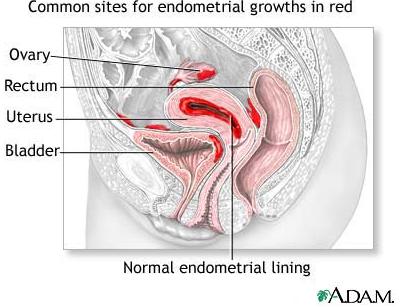
Endometriosis is a chronic pelvic pain condition that involves tissue that is similar to the uterine lining growing outside of the uterus. Structures that can be affected includes the ovaries, fallopian tubes, bladder, and bowel. Endometrial growths can also be found outside the pelvic region. Endometriosis can cause severe pelvic bloating, abdominal-pelvic pain, constipation, painful menses, bladder pain or urinary frequency, painful intercourse, and possible fertility issues. From endometriosis, surrounding tissues can become inflamed, irritated, and adhesions may form. Pelvic organs can become adhered to adjacent structures. These adherences can be a cause of the pelvic pain. Pelvic nerves can also become irritated and inflamed acting as a pain generator. Associated musculoskeletal dysfunction can include pelvic floor muscle dysfunction/overactivity, abdominal muscle myofascial trigger points, impaired mobility/motility of abdominal-pelvic organs, hip pain, low back pain, pelvic pain, and vulvovaginal pain.
How can Pamela Morrison Physical Therapy help with Endometriosis?
The best way to approach endometriosis is through a multidisciplinary approach which includes a skilled and experienced physical therapist that specializes in pelvic pain and myofascial release techniques, including visceral mobilization. At Pamela Morrison Physical Therapy, your expert pelvic rehab specialist will perform an extensive medical history and a physical exam which would include specific testing of your pelvic structures. Joint alignment and mobility, connective tissue mobility, pelvic nerve function and mobility testing, pelvic organ mobility/motility are assessed as well as pelvic and abdominal muscle palpation to identify tender points, trigger points, and tightness. Areas of painful pelvic adhesions and scar tissue are easily identified via our skilled therapist’s connective tissue mobility and palpation tests. Rehabilitative real-time ultrasound and palpation can help identify pelvic floor muscle dysfunction. Based on the evaluative findings, a comprehensive treatment program will be initiated. Treatment techniques may include modalities for pain such as moist heat, TENS, ultrasound, or cold laser. Manual therapies such as myofascial release, scar release techniques, visceral (organ) manipulation, trigger point releases techniques, neural tension release techniques, and joint mobilization would be utilized. Other treatment approaches may include stretching exercises, therapeutic exercises, dilator therapy, and pelvic floor muscle rehab. Patients find significant or full relief after being treated at our practice.


